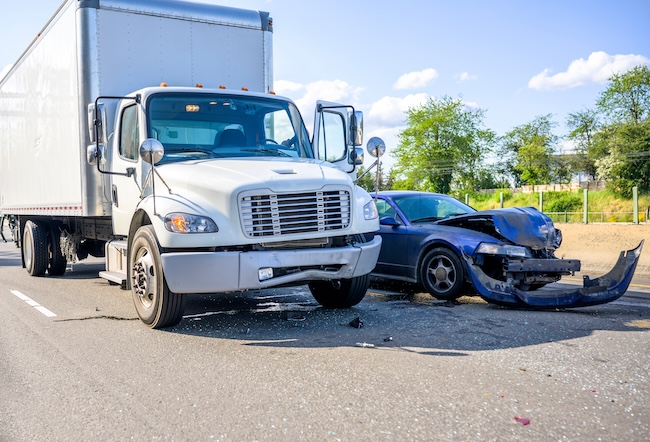Driving with a compression fracture can be tough, you need to pay attention to recovery timelines, physical limitations, and safety precautions. Whether your injury was from a traumatic accident or a chronic condition like osteoporosis, daily life – including getting back on the road – requires a plan to avoid further harm.
In this blog, we’ll discuss the challenges of driving with a compression fracture, medical guidelines for safe recovery, tips for a smooth return to driving, and why you should consult with an Atlanta personal injury attorney to protect your legal and financial interests.
Compression Fractures
A spinal compression fracture occurs when a vertebra in the spine collapses, often due to weak bone structure. The fracture causes the vertebra to shrink in height which can cause a lot of pain and loss of mobility. These fractures are common in people with osteoporosis where bones become brittle and fragile. Traumas such as falls or car accidents can also cause this injury in healthy and compromised bones.
Symptoms and Physical Limitations
The main symptom of a compression fracture is significant pain, which can be acute and worsens with standing or movement. This pain forces people to adopt positions that ease the discomfort but those positions can further reduce mobility and affect posture. In severe cases, the fracture can cause a visible curve or hunch in the spine (kyphosis). Some people may experience numbness or tingling if the fracture compresses nearby nerves which can affect motor skills.
Treatment and Rehabilitation for Compression Fractures
Treatment and rehabilitation for compression fractures are about pain management, mobility, and preventing future injuries through a combination of medical interventions, physical therapy, and lifestyle changes. Proper immobilization and reduction of fractures are crucial for the healing process. Pain medication assists in managing discomfort caused by spine compression fractures, facilitating mobility during recovery, but it does not accelerate the healing process.
Initial Treatment Phases
The first phase of managing a compression fracture is to reduce pain and stabilize the area. Rest is key during the acute phase to allow the fracture to start healing. Pain management is over-the-counter pain meds or prescribed meds such as nonsteroidal anti-inflammatory drugs (NSAIDs) or calcitonin for severe pain. In some cases, a back brace may be recommended to limit movement and support the spine to prevent further injury during the early stages of recovery.
Long-Term Pain Management
If chronic pain persists a combination of pharmaceutical and non-pharmaceutical approaches may be used. Meds such as muscle relaxants or nerve pain modulators can be used under medical supervision. Non-invasive therapies like massage, acupuncture, or transcutaneous electrical nerve stimulation (TENS) can provide additional relief. Ongoing pain management allows people to stay active and maintain their quality of life during recovery.
Preventing Future Fractures
Preventing recurrence is part of the treatment. Patients are encouraged to make lifestyle changes that promote bone health such as increasing calcium and vitamin D intake and weight-bearing exercise. Quitting smoking and reducing alcohol consumption also helps bone density. Medical professionals may also monitor bone health with regular bone density scans to assess the risk of future fractures and adjust treatment plans as needed.
Driving with a Compression Fracture
Driving with a compression fracture brings physical, cognitive, and safety challenges that need to be managed to ensure personal well-being and the safety of others on the road. Resuming normal activities, including driving, requires careful consideration of these challenges to prevent re-injury and ensure a safe recovery.
Risk Factors for Driving
Driving with a compression fracture presents several challenges due to physical limitations and safety risks. Limited spinal mobility makes it hard to do tasks like checking mirrors, turning to check blind spots, or rotating the neck. Pain and stiffness can also slow down reaction time making it more likely to react late in critical driving situations. Prolonged sitting while driving can also worsen back pain and compromise focus and comfort behind the wheel.
Medical Advice for Driving
During the acute phase medical professionals usually advise not to drive to prevent further injury. While many spine compression fractures do not require surgery, some severe cases may still necessitate it. The use of back braces prescribed for support can limit upper body mobility and make it hard to maneuver safely. Doctors advise waiting until the pain is manageable and the patient has enough strength and mobility to drive again. Follow medical advice closely as driving too soon can increase the risk of re-injury and accidents.
Medical Guidelines for Safe Driving Post-Fracture
Medical guidelines for driving post-fracture are full recovery, professional clearance, and tailored adjustments to ensure personal safety and responsible driving.
Clearance Criteria for Driving
Before driving again medical professionals will assess the patient’s mobility, strength, and pain to ensure the safe operation of a vehicle. The patient must show sufficient recovery in spinal flexibility and upper body movement to perform basic driving tasks like steering and checking blind spots. Full clearance is usually given when pain is managed without meds that impair judgment or alertness.
Legal and Recovery Timeframes
There is no universal legal time frame for driving post-fracture but patients on medical leave are usually advised not to drive until cleared by their doctor. Recovery timeframes vary depending on the severity of the fracture, more complex cases require longer periods of rest and rehabilitation. Patients must follow these timeframes even if they feel they can drive sooner than recommended.
Getting Back to Driving
A safe return to driving after a compression fracture requires planning, physical readiness, and gradual reintroduction to ensure comfort and safety on the road.
Pre-Driving Physical Prep
Before driving again patients should gradually build up their strength, flexibility, and endurance through low-impact exercises. Stretching exercises for the back, shoulders, and neck will help restore the range of motion needed for turning and checking mirrors. Core strengthening exercises will enhance spinal support and reduce the risk of pain flare-ups while driving. Patients should consult a physical therapist to get an exercise plan tailored to their recovery.
Test Drive Readiness
Testing readiness to drive is more than just physical strength, it’s about comfort and mobility in the seated position. Patients should practice sitting for long periods to see if they can tolerate the duration of a typical drive without discomfort. Simulate driving movements like reaching for the steering wheel or checking blind spots to see what physical limitations are left. Short test drives in an empty parking lot are a low-risk way to test your abilities.
Vehicle Adjustments
Ergonomic adjustments can make driving safer and more comfortable for patients with compression fractures. Adjust the seat to give optimal lumbar support to reduce strain on the lower back. Mirrors should be adjusted to minimize upper body twisting. If needed lumbar cushions or back braces can be used during the drive but use them carefully so you don’t restrict movement.
Consult With an Experienced Atlanta Personal Injury Attorney ASAP!
If you’re recovering from a compression fracture caused by an accident and need legal guidance, our team at Buddoo & Associates is here to help. We’ll work tirelessly to protect your rights, handle your claims, and ensure you receive the compensation you deserve.
Contact us at 404-870-3557 for a free case review today!








